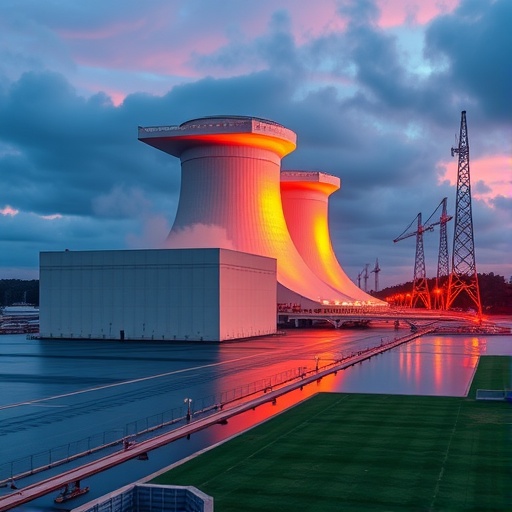The upcoming 2025 Fall Meeting of the American Physical Society’s Division of Nuclear Physics promises to be a landmark event in the field of contemporary nuclear science. Hosting hundreds of physicists from across the globe, the conference is set to take place in-person exclusively at the Hilton Chicago in Chicago, from October 17th to 20th. This gathering is anticipated to facilitate deep scientific discourse on breakthrough nuclear physics research, providing a platform for presenting pioneering data that could redefine existing paradigms.
Press accreditation for this significant meeting is available to qualified news media at no charge, ensuring broad coverage and dissemination of cutting-edge discoveries. Interested journalists with valid APS press credentials have the opportunity to register ahead via the APS portal, with registration remaining open throughout the duration of the meeting. This accessibility underscores the APS’s commitment to transparency and the promotion of scientific literacy worldwide.
The scientific agenda is remarkably comprehensive, encompassing a variety of complex topics such as the behavior of exotic and radioactive nuclei, the quark-gluon plasma state, nucleosynthesis processes, neutrino physics, and much more. Each presentation is crafted to shed light on intricate nuclear phenomena, contributing to a cohesive understanding of the subatomic world and its implications for both theoretical frameworks and practical applications.
One particularly anticipated presentation is titled “Observation of an Ultra-High Energy Cosmic Neutrino with KM3NeT,” scheduled for October 18th at 2:36 p.m. in Continental A. This talk explores groundbreaking detection events related to ultra-high energy neutrinos—ghostly particles that pass through matter almost undisturbed—captured by the KM3NeT detector array. Such observations are crucial for advancing astrophysical neutrino studies and understanding cosmic ray origins at unprecedented energy scales.
Another intriguing session titled “Photoactivation Analysis Studies at the Madison Accelerator Laboratory to Investigate the Copper Origin of Artifacts Excavated in the Vicinity of the ‘Lost’ Roanoke Colony” delves into the crossroads of nuclear techniques and archeological mystery. Scheduled for the same day at 4 p.m. in the International Ballroom North, this poster presentation applies nuclear photoactivation methods to examine the elemental composition of historical artifacts, offering insights into early American colonization and trade networks through preciseochemical fingerprinting.
The conference will also feature the “Study of Radon Progeny Attachment Suppression,” emphasizing novel strategies to mitigate radon decay product attachment in detector environments. This session highlights advances in controlling radon-related background noise in experiments, a perpetual challenge in nuclear physics and radiological detection fields. Slated for October 19th morning, the talk will detail the mechanisms regulating progeny interactions and innovative suppression methodologies essential for enhancing experimental sensitivity.
Further emphasizing nucleosynthesis dynamics, the presentation entitled “Enhanced Production of 60Fe in Massive Stars and Supernova Explosions” scrutinizes the astrophysical processes driving the synthesis of this radioactive isotope in stellar environments. The findings have profound implications for understanding the lifecycle of stars and the chemical evolution of our galaxy, elucidating the pathways through which heavy elements are forged in cataclysmic events, thereby enriching interstellar matter.
Expanding the investigative scope, “Production and Spectroscopy of Cold Radioactive Molecules in a Tabletop Apparatus” introduces revolutionary experimental techniques to generate and study ultra-cold radioactive species. This research integrates spectroscopic analysis with advanced cooling methods, enabling precise measurement of molecular structure and decay processes under controlled laboratory conditions. The innovative tabletop setup not only democratizes access to complex nuclear chemistry studies but also facilitates fundamental inquiries into molecular interactions and radioactive decay kinetics.
The APS Division of Nuclear Physics’ 2025 Fall Meeting epitomizes the forefront of cutting-edge research by amalgamating interdisciplinary studies that range from cosmic particle detection to nuclear reaction theory and from experimental innovations to applied science. Such a confluence elevates knowledge boundaries and propels forward the physics community’s comprehension of both microscopic and macroscopic nuclear phenomena, serving as a catalyst for future theoretical and technological breakthroughs.
The event’s collective emphasis on fundamental and applied nuclear sciences underscores ongoing efforts towards harnessing nuclear processes for energy generation, medical applications, and beyond. This conference, backed by the American Physical Society’s vast network of over 50,000 physicists in academia, national labs, and industry, reflects the vibrant, inclusive scientific dialogue aimed at tackling some of the most profound questions about matter, energy, and the universe.
Journalists and researchers alike will find this meeting invaluable as it promotes interaction among experts specializing in subatomic particles, nuclear reactions, radioactive decay pathways, and related astrophysical phenomena such as supernovae. This nexus of collaboration is essential to sustaining innovation in physics, from conceptual theory development through to experimentation and practical implementation.
As the meeting approaches, attention is also drawn to the broader implications of the research showcased. Understanding nuclear fusion, reaction theory, and nucleon behaviors not only enrich fundamental science but also inform emerging technologies in energy, healthcare, and environmental monitoring. By illuminating the nuances of nuclear reactions and particle physics, the conference positions itself at the heart of 21st-century science and technology advancements.
For media inquiries, the APS Press Office, led by Nyla Husain, remains available for assistance and further information dissemination. Their commitment to supporting broad coverage ensures that the latest discoveries in nuclear physics reach diverse audiences, fostering public engagement and inspiring the next generation of physicists.
The 2025 Fall Meeting promises to be more than a simple academic conference; it represents a confluence of human curiosity, scientific rigor, and collaborative synergy. The insights gained here will not only inform academic textbooks and research journals but may also lead to technological innovations that reshape how society harnesses the fundamental forces of nature.
Subject of Research: Advanced nuclear physics including exotic nuclei, cosmic neutrinos, nucleosynthesis, and radioactive decay.
Article Title: Cutting-edge Research to Unveil the Mysteries of Nuclear Physics at the 2025 APS Fall Meeting
News Publication Date: Not specified (Event dates: October 17-20, 2025)
Web References:
– https://www.aps.org/events/2025/division-nuclear-physics-2025
– https://schedule.aps.org/dnp/2025/schedule/
Image Credits: Not provided
Keywords
Physics, Nuclear energy, Nuclear physics, Nuclear reactions, Nuclear fusion, Radioactive decay, Radioactivity, Cold fusion, Electron reactions, Nuclear reaction theory, Neutrinos, Nucleons, Quarks, Supernovae, Radon




